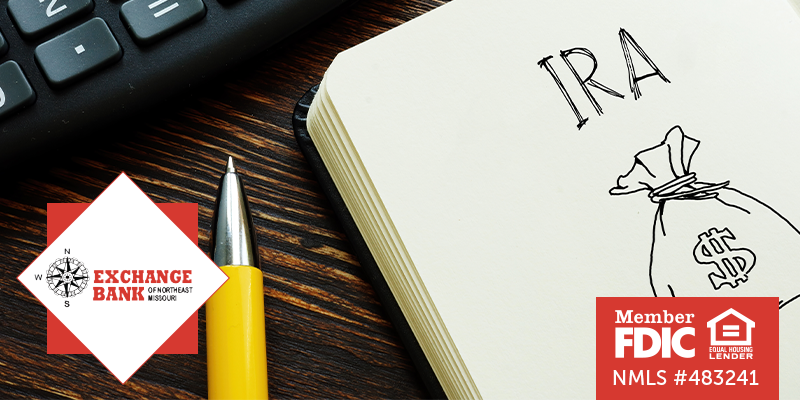Exchange Bank of Northeast Missouri
Updated 2:56 PM CDT, Thu April 3, 2025
Published Under: Budgeting Personal Finances Retirement Savings

Why should I worry about saving for retirement right now? Are IRAs really that important? If you are questioning the importance of saving for retirement and what can drastically affect your future, you’ll want to continue reading. We wanted to provide a beginner’s guide to IRAs so you can understand your options and the differences between IRAs.
What is an IRA?
An individual retirement account (IRA) is basically a savings account with tax advantages for you to use to prepare for retirement. There are several different types of IRAs, including Traditional IRAs, Roth IRAs, and SEP IRAs.
What are different IRA options?
A Roth IRA or Traditional IRA are two options. These will be explained in the next section. Other options may be a SEP IRA which stands for simplified employee pension. A nondeductible IRA may be an option if you (or your spouse) have a retirement plan at work and your income exceeds the IRA income limits, then you may not be able to deduct your traditional IRA contributions. There are others out there, but these are the most common you would come across based on your employment.
What is the difference between a Roth and Traditional IRA?
For starters, with a Roth IRA, you contribute after-tax dollars, your money grows tax-free, and you can generally make tax- and penalty-free withdrawals after age 59½. With a Traditional IRA, you contribute pre-tax dollars, your money grows tax-deferred, and withdrawals are taxed as current income after age 59½. Investopedia states, “Roth IRAs are similar to traditional IRAs, with the biggest distinction between the two being how they’re taxed. Roth IRAs are funded with after-tax dollars; this means that the contributions are not tax-deductible. But once you start withdrawing funds, the money is tax free. Conversely, traditional IRA deposits are generally made with pretax dollars; you usually get a tax deduction on your contribution and pay income tax when you withdraw the money from the account during retirement.” Your tax preparer can help you figure out the best option for you. To learn more, click here: https://www.irs.gov/retirement-plans/traditional-and-roth-iras
How much should I be saving for retirement?
There are lots of different ways to be sure you are saving enough for retirement. When you retire, you’ll need to factor in monthly bills, living expenses, rent, loans, medical bills, travel and so on – so it does add up quickly! One way to be sure you are saving enough is to look at your age. In your twenties, one rule of thumb is to save 10% to 15% of your pay for retirement. By thirty, you’ll want it to be at least 15%. At 40, you should aim to save 3 times your salary. Consulting a financial advisor will also be helpful, so you can determine how much to save and also how much to contribute to other areas such as a savings account or 401k.
We hope this helps you feel more confident about beginning to save for retirement with an IRA. We offer solutions for you along with any other help you may need financially. Reach out to us today!
Exchange Bank of Northeast Missouri
Member FDIC
Equal Housing Lender
Comments